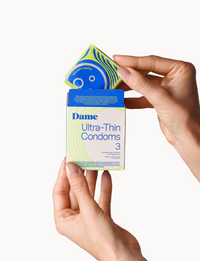Birth is unpredictable, and things don’t always go according to plan. And even when they do, things can still be perceived as traumatic. How can you heal? Can you prevent birth trauma? And what does intimacy look like after birth trauma? What’s birth trauma and who experiences it? How often does it happen? Birth trauma can be hard to define because, ultimately, it’s a subjective experience. But as many as 20% and 48% of birthing persons worldwide report their birth experiences to be traumatic, which can lead to symptoms like hypervigilance, anxiety, panic attacks, or detachment. Birth trauma is not limited to a birthing person, as a partner, friend, or birth attendant could also experience birth trauma, though this prevalence is less clear in the current literature. Despite having 40 (or so) weeks to ‘plan’ your delivery, ultimately, birth is unpredictable. It can be experienced across a huge continuum of emotions from happiness, joy, relief, or traumatic, sadness, anger, regret. The physical experience of giving birth is also incredibly diverse. Lots of factors play into this, like the complexity of pregnancy and delivery, support system, race, access to quality care, and socioeconomic status, but how these factors impact someone’s birth experience vary widely from person to person. Certain factors appear to increase the risk for birth trauma, such as folks with pre-existing mental health disorders, as well as those who undergo obstetric emergencies (a life-threatening complication to baby or birthing person) and neonatal complications, such as jaundice or birth injuries. But, what’s really interesting, is it may not be the act of giving birth itself that’s traumatic- it’s the way someone was treated and cared for that was traumatic. Another major risk factor for experiencing birth trauma is poor quality of provider interactions, with complaints like poor communication, not being taken seriously, or lack of autonomy/involvement in the decision making process.
It can be really difficult to find time to address mental health with the new wave of responsibilities as a parent . . . but it can make a big difference in the healing process.
Can you prevent birth trauma? Yes and no. You can’t predict or guarantee length of labor, route of delivery, or perineal tearing (though you can potentially reduce your risk), but you can build a robust support system during pregnancy. This could include immediate family but it certainly doesn’t have to- anyone you feel supported by would be appropriate to include in your circle. Birthing classes may help to educate and form realistic expectations about labor and delivery. If you have the privilege of choice, find a birthing provider you connect with and who makes you feel heard. If you are concerned about advocating yourself, a doula can be a fantastic resource if you have access to one in your area. Intimacy after birth trauma Intimacy after birth, in general, can look a little… different. There’s shifting roles from partner to parent, logistical complications to get busy with a newborn, and physical changes that occurred during pregnancy and birth that can affect your experience of intimacy. All of these changes can also be compounded by the emotional and psychological involvement of birth trauma. Particularly if someone had a physically traumatic birth, like an unplanned Cesarean (c-section), or use of forceps/vacuum, intimacy and touch can feel really daunting, even in the absence of penetration. After all, a literal human just exited you! Easing fear surrounding intimacy postpartum is often less about physical healing and more about the nervous system. One of the key features of birth trauma is hypervigilance or hyperarousal, meaning the nervous system is on overdrive most or all of the time, which can impact the way someone experiences pain. Pain exists because it’s protective and it’s supposed to tell us when tissue damage has occurred or is about to occur, like when you withdraw your finger from a hot stove. The trouble is, pain can exist in the absence of tissue damage. Pain is processed not in the physical structures that are injured but in the brain, where it becomes a subjective and variable experience. When you experience anything traumatic, birth related or not, the brain may start perceiving something as innocuous as intimate touch as something that’s creating tissue damage. This is called ‘central sensitization’, when the brain can’t differentiate between touch that causes tissue damage and touch that’s not harmful. So what can you do to make intimacy easier?
- First, assess for and treat physical causes like perineal tears, that can make sex uncomfortable. Don’t forget the lube!
- Communicate with your partner what feels good and what feels less desirable
- Try some desensitization techniques if you’re concerned about central sensitization: take an area of the body that feels guarded, like a c-section scar, perineum or vulva, and start to retrain the brain that touch does not equal tissue damage. Start by using soft materials to lay or rub on the area, like a cotton ball, silk, or a cotton t-shirt. Find a threshold that is non-painful, and progress from there to using a finger, a toy or a partner’s hand. Don’t rush this- it’s about having a conversation with your nervous system, and that takes time to create change.
- Get your head in the game with reassuring thoughts, as well as be intentional about the timing of intimacy when your nervous system can relax, like when baby’s asleep
- Trauma is trauma is trauma. Birth trauma often has a psychological/emotional component, and can benefit from a lot of the same interventions as other trauma, which this article beautifully explains. It can be really difficult to find time to address mental health with the new wave of responsibilities as a parent, as well as childcare often being a significant barrier, but it can make a big difference in the healing process.
Don’t wait to seek help If you’ve experienced a traumatic birth, many resources are available to help you heal.
- Postpartum Support International has several phone lines, peer support, and can help you locate a trained professional
- City Birth Trauma Scale is a recent and validated measure to screen for postpartum PTSD
- If you’re concerned that there may be physical causes limiting intimacy, talk to your OB/GYN, midwife or a pelvic floor physical therapist
Though the healing process is rarely linear, it’s worth putting in the time and the effort. We can’t control every aspect of our birth experience, but we can control how we heal and recover from it.




















































